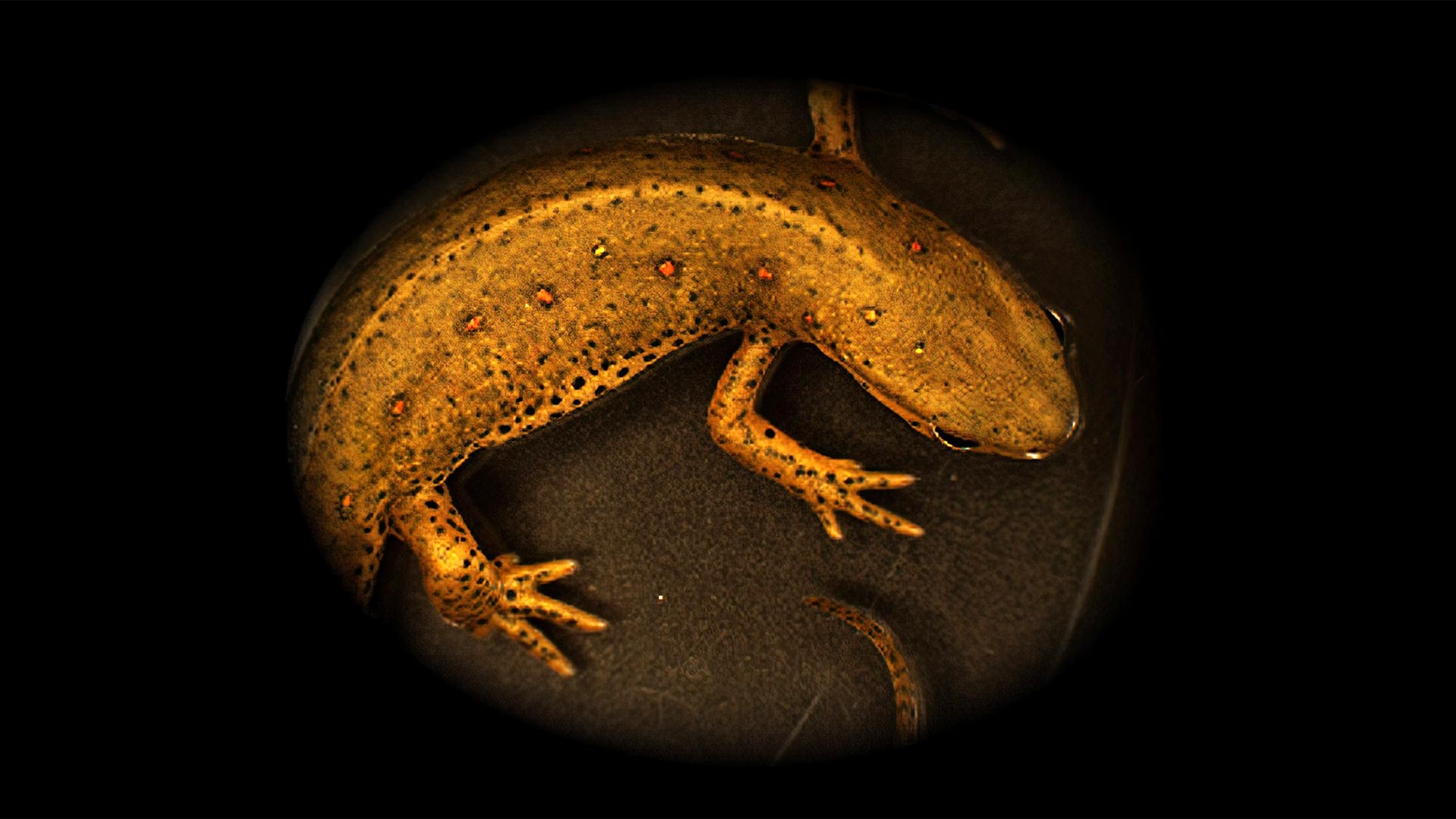La especie de salamandra estudiada por el grupo de Yoon: Salamandra de puntos rojos Notophthalmus viridescens. Al estudiar las salamandras, que tienen notables habilidades regenerativas, los investigadores han descubierto que la presencia de células senescentes acelera el proceso de regeneración de las extremidades. Las células secretan factores que envían señales a las fibras musculares maduras para que se transformen en antiguas células musculares, lo que promueve la regeneración. Este hallazgo podría ayudar a los investigadores a comprender por qué los humanos tienen capacidades de regeneración limitadas y posiblemente desarrollar nuevos tratamientos para enfermedades relacionadas con la edad. Crédito: Maximina Yun
Los científicos han demostrado que las llamadas células senescentes, es decir, células que han dejado de dividirse permanentemente, promueven la producción de nuevas células musculares para promover la regeneración de las extremidades perdidas en las salamandras.
Las células senescentes, asociadas con el envejecimiento y la enfermedad, pueden tener propiedades regenerativas. Al estudiar las salamandras, los investigadores descubrieron que las células senescentes aceleran la regeneración de las extremidades al indicar a las fibras musculares que se desdiferencien, lo que podría conducir a nuevos tratamientos para enfermedades relacionadas con la edad.
Las células senescentes son células que han dejado de dividirse permanentemente en respuesta al estrés celular pero que no han muerto. A medida que los organismos envejecen, aumenta el número de células senescentes en el cuerpo. Esta acumulación se considera actualmente un sello distintivo del envejecimiento y se ha relacionado con una variedad de enfermedades, incluido el cáncer. Sin embargo, la verdadera naturaleza de estas células puede ser más compleja y depender del contexto.
Un creciente cuerpo de evidencia sugiere que las células senescentes también pueden tener efectos beneficiosos, como curar heridas o prevenir la cicatrización de tejidos. «Hace unos años, nuestro grupo descubrió que las células senescentes estaban presentes en las etapas clave de la regeneración de las extremidades de la salamandra. Curiosamente, otros grupos encontraron posteriormente estas células en otros contextos de regeneración, incluso en mamíferos. Por lo tanto, queríamos ver si estas células contribuyen De cualquier manera, puede regenerarse a sí mismo”, explica la Dra. Maximina Jön, líder del grupo de investigación en el Centro de Terapias Regenerativas de Dresden (CRTD) y el grupo de Física de Excelencia (PoL) en TU Dresden y el Instituto Max Planck en[{» attribute=»»>Molecular Cell Biology and Genetics (MPI-CBG).
Senescent Cells Promote Regeneration
The researchers in Yun’s group study salamanders. These animals have unique regeneration abilities and are able to re-grow many organs of their bodies, including lost limbs. “Salamander limb regeneration is a fascinating process. In a matter of weeks, they re-grow a fully functional limb,” explains Dr. Yun.
To check if the presence of senescent cells influences the limb regeneration process, researchers in the Yun group found a way to modulate the number of senescent cells in the wound. The team observed that the presence of senescent cells enhanced the regeneration process.
“When more senescent cells were present in the wound, the animals developed a larger regeneration bud, or – as we call it – blastema. This is a collection of cells that are going to form all the needed tissues in the new limb. The larger the blastema, the more cells are there to regrow the limb and the quicker the regeneration process. The presence of senescent cells seemed to ‘fuel’ the regeneration process,” Dr. Yun says.
“Zombie” Signaling Promotes New Muscle Cells
Looking more closely at the blastema with and without the influence of the senescent cells, the Yun team uncovered a new mechanism that enhances the regeneration process and found that the presence of senescent cells increased the number of regenerating muscle cells. They showed that senescent cells secrete factors that stimulate nearby muscle tissue to take a developmental step back and produce new muscle.
“Our results show that senescent cells use cell-cell communication to influence the regeneration process. They secrete molecules that signal to mature muscle fibers to dedifferentiate into muscle progenitor cells. These cells can multiply themselves as well as differentiate into new muscle cells, thereby enhancing the regeneration process. This signaling appears to be an important part of promoting regeneration,” says Dr. Yun.
For now, the group focused on muscle, one of the most important tissues in the regenerating limb. However, the team is already investigating whether senescent cell signaling also contributes to the regeneration of other tissues.
Lessons From the Salamanders
Yun’s group is working with salamanders to study regeneration and aging processes. “Salamanders are one of the few animal species that seem to defy the natural aging process. They do not develop typical signs of aging and do not accumulate age-related diseases such as cancer. They also have extraordinary healing abilities,” says Dr. Yun. The animals can regenerate almost any organ in their body.
Studying salamanders is helping Dr. Yun and her colleagues at the CRTD understand the principles of the regeneration process and, in the long run, may help solve the puzzle of why humans have very limited regenerative abilities.
Reference: “Senescent cells enhance newt limb regeneration by promoting muscle dedifferentiation” by Hannah E. Walters, Konstantin E. Troyanovskiy, Alwin M. Graf and Maximina H. Yun, 6 April 2023, Aging Cell.
DOI: 10.1111/acel.13826

«Viajar ninja. Alborotador. Erudito del tocino. Experto en alcohol extremo. Defensor de los zombis».







More Stories
Los legionarios realizan dos cruceros separados vinculados a esta característica especial de lujo: informe
La supernova vista por primera vez en 1181 libera filamentos brillantes
SpaceX lanza 20 satélites de Internet Starlink desde California el 30 de octubre